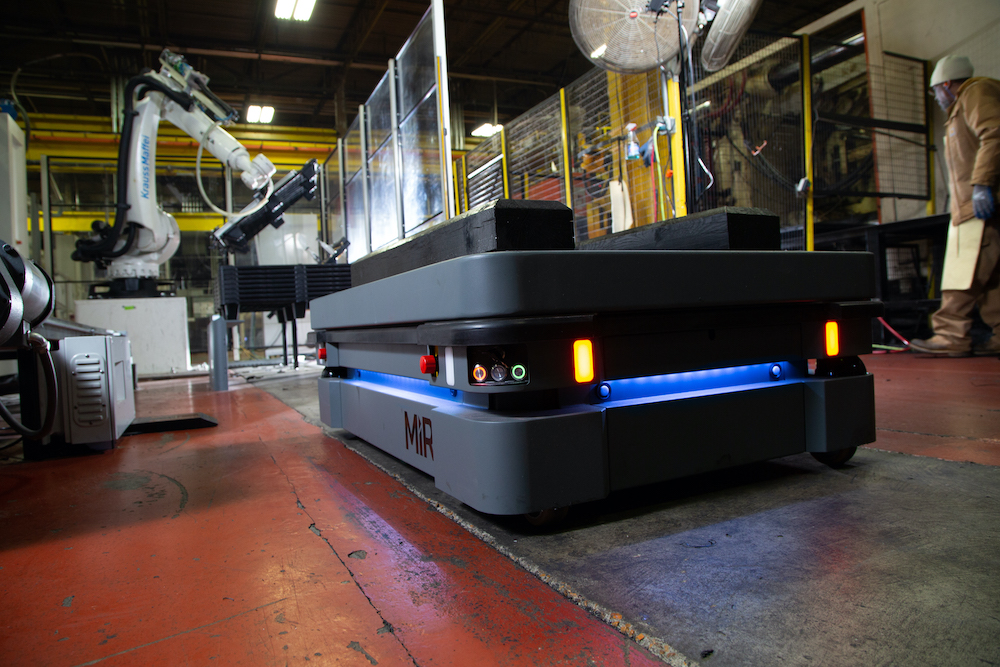
The changing face of the shop floor: Q&A with Ed Mullen, Mobile Industrial Robots
June 11, 2020
By
Kristina Urquhart
 Photo: Mobile Industrial Robots
Photo: Mobile Industrial Robots Mobile Industrial Robots (MiR), which produces autonomous mobile robots (AMRs), recently announced it’s building a $36-million collaborative robot hub with Universal Robots in Europe. We recently talked to Ed Mullen, MiR’s VP sales for the Americas, to see how the AMR business is picking up speed stateside.
Manufacturing AUTOMATION: How is MiR meeting new demand for these vehicles?
Ed Mullen: This is fairly new technology with regard to autonomous material handling and our strategy still remains focused on educating our partners and educating the general manufacturing audience on what an AMR can do for their business. Our business over the last four years has been selling low-volume seed units into large multinational companies.
Now we’re in a transition phase, where a lot of these early-on proof-of-concepts are starting to turn to bigger deployments. Companies are now comfortable with the technology, and they understand how to apply it. They’ve identified applications that are showing a positive return on investment.
Our focus now is leaning more towards building up a team of resources that can help with bigger deployments. That leads us to a system integrator program that we’re starting to develop. Companies that act as integrators can now partner with us and we can leverage their capabilities to assist in these larger deployments.
MA: What challenges do you currently face with education?
EM: We want to be able to just allow an end user to take full ownership of the product and evolve it as their business changes. That’s really what manufacturing has grown into – it’s more of an agile environment where one week they may be doing one type of product and another week they may be doing a completely different product on that same production line. And that’s the appeal of cobots and AMRs – this flexibility and adaptability, and the ability to have a customer take ownership and change the function of the piece of automation.
MA: How does MiR Americas support Mobile Industrial Robots, which is based in Denmark?
EM: We’ve implemented a team of application engineers now that are on top of our tech support engineers. The focus of us in the Americas is to provide the highest level of support, both sales and technical. This team is another mechanism to assist customers more intimately on commissioning robots and make sure that they understand the technology, and that they apply it correctly.
MA: What specific advancements has MiR made with the artificial intelligence of its AMRs?
EM: We’ve been investing more and more into artificial intelligence (AI). We’ve launched our first product, which is the static AI camera that can be mounted in more challenging locations within a manufacturing environment.
We can start to learn the environment and feed that data back to our fleet system so that the fleet can help make the robots more efficient in the environment, make better decisions on where to navigate and where not to navigate during certain times of the day, or recognize when certain things are present or not present, to determine when and where to dispatch the robot.
As we progress through developing and expanding our product line of AI technology, that will be the next phase, to put a dynamic AI camera integrated into the robot, so that we can learn the environment even better as we’re navigating around.
What’s been your strategy so far on partnering with other companies to offer tooling for MiR’s AMRs?
EM: Instead of developing solutions and forcing customers to work with our solutions, our strategy has been, let’s give customers a tool and let them develop the proper solution for the application. We’ve got a couple of solutions that made a little more sense for MiR to integrate into our robots. For example, for the bigger robots, we have a pallet movement system, which lifts a pallet off of a rack, and we supply the lift and the rack as an accessory to the robots to put together a solution.
Even more important than this is giving external companies the tools to integrate solutions very easily into our platform. What we’ve started to organize this past 24 months is a program called MiR Go. It’s an ecosystem that allows external companies to develop solutions and post them on our MiR Go site.
It exposes those solutions to the general audience worldwide. It allows companies to go to that site, look at specific solutions, contact those companies and buy an already designed, manufactured solution for that particular application if it fits.
What should manufacturers be aware of safety-wise, since AMRs move freely around a production facility?
EM: Our robots have built-in safety with Cat 3/PLd. Specifically, there’s not much that they have to do to change their environment with regard to safety in order to use the robots. Our robots are fully compliant to work around people in traffic areas.
But if you think about what that does – it will slow the robots’ speed down when it has more obstacles in front of it. What we’re seeing is customers are reviewing processes and procedures and creating lanes so that the robots can see a faster throughput and better track times between pickup and drop-offs.
What should a manufacturer consider when evaluating whether an AMR is right for their facility over another type of automated guided vehicle (AGV)?
EM: Floor space is becoming a premium. The general environments are becoming much more condensed than they were 15 or 20 years ago. Twenty years ago, AGV technology was very prevalent in the bigger companies, [which] could afford to dedicate a particular lane for an AGV – and that static route, where that AGV just does the same thing over and over, all day long, seven days a week, is the way they would generate an ROI on it.
How do AMRs help with the skills shortage?
EM: The task of moving things is not a high-skilled job. If you look at a general manufacturing environment, where you’ve got a skilled operator that’s doing a high-level task [like] running a stamping machine or a CNC machine, and [they’ve] got to stop what [they’re] doing to take those products on a machine to another process by carrying, pushing or pulling – that’s where we see the inefficiency of that operation.
If we can keep the skilled labour doing what makes the company money and bring in autonomous robots to handle the material movement, that’s where you’ll start to see the higher-efficiency model start to shine.
This interview has been condensed and edited. It originally ran in the April 2020 edition of Robotics Insider, Manufacturing AUTOMATION’s quarterly e-book about industrial robotics.
Advertisement
- SICK debuts digital solutions portfolio for access to sensor data
- PDTA report shows power transmission and motion control industries in decline until 2021
